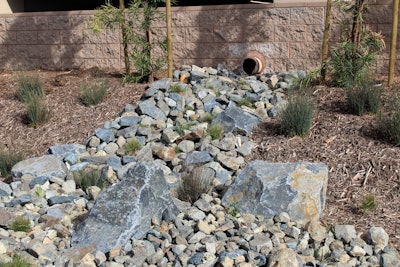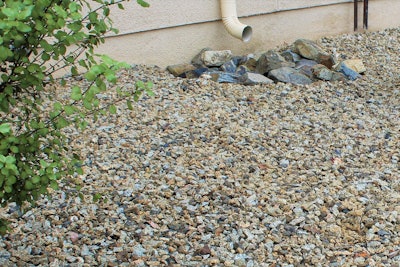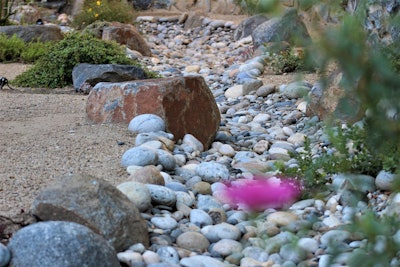 Photo: Wholesale Stone Solutions
Photo: Wholesale Stone SolutionsErosion is a common pain point that can cause customers to seek out your landscaping services to help remedy the problem.
One solution is the strategic usage of stone in the landscape to help mitigate the effects of water erosion.
“Unlike man-made products that typically break down over time, whether it’s concrete or wood or anything like that, a good hard stone is the most durable option out there,” says Randy Jurgensen, president of Wholesale Stone Solutions. “The other thing is its availability and cost. It’s typically readily available in most areas of the United States and it’s fairly inexpensive for the material costs. The installation costs can be a little high, but the material costs are fairly low.”
 Photo: Wholesale Stone Solutions
Photo: Wholesale Stone SolutionsLocations that are most susceptible to water erosion include slopes, areas around naturally flowing water during rain events and non-vegetated areas. Another area that can benefit from the addition of stone is under downspouts, as it can help disperse the energy of the water channeled from rain gutters.
“Stone is the best used in areas that are either getting a lot of erosion to keep it from getting worse or areas that you think are going to be susceptible and still have good soil and some established vegetation,” Jurgensen says. “That’s being proactive about it as opposed to trying to fix something that’s already happened.”
Methods of control
The two main methods of control stone that can be used when dealing with erosion are retaining walls and dry streambeds.
Retaining walls are well-suited for sloped yards, as they can prevent water from picking up too much velocity and force. Terraced retaining walls slow the water flow by forcing it across flat areas before reaching the next retaining wall. With less energy, the water isn’t able to cause as much damage compared to rushing down a slope unimpeded.
 Photo: Jill Odom/Total Landscape Care
Photo: Jill Odom/Total Landscape Care“Terraced retaining walls is one where the beauty of that is it also enhances the usability of the property, so you’re creating more flat spaces on the property that are usable versus just a slope, and typically it also improves the aesthetics of the property, not just usability but the look as well,” Jurgensen says.
The other common application for stone in erosion situations is creating a dry streambed in areas where water occasionally flows during a rain event.
“You want to line those channels where water flows with stone in order to keep the edges and banks of that area stable and shore it up with stone, and then ideally you vegetate the areas both between the retaining walls and around these dry streambeds, because the more root systems you have in the soil, the more that soil is going to be able to stay in place during these water events,” Jurgensen says.
When installing stones for erosion control, they should be installed at a greater depth than those being used for decorative ground cover. Jurgensen says many installations that use stone for controlling water erosion will have the stone set in a concrete slurry to keep them in place. Another option is to use geosynthetic fabric, which helps prevent the material from migrating downhill.
“A geosynthetic fabric is typically a non-woven material, so it’s just punched with thousands of tiny holes in it opposed to a fabric that has been woven together,” Jurgensen says. “In that way, it tends to be stronger from any lateral forces that are put onto it and doesn’t clog up with soil over time versus a woven landscape fabric that can get clogged over time with minute particles filling in all the void spaces.”
As for what type of rock to use in this sort of application, the size and shape are what matters the most. The rule of thumb is the heavier the flow of water, the larger stones need to be to ensure they are not displaced. Also, angular rocks are able to lock together better than rounded rocks.
 Photo: Decorative Stone Solutions
Photo: Decorative Stone SolutionsThis isn’t to say you can’t ever use rounded stones, and in fact, they are often used for dry streambeds to maintain a natural appearance. Jurgensen says it all depends on the flow of water the stones are dealing with.
“I wouldn’t say it’s a bad choice if the water flow is fairly minimal and low and it’s not high-speed water flowing through there, it’ll work,” he says. “You can absolutely use angular rock in the same fashion and make it look fairly nice and natural, but it all depends on the force of water flowing through that area.”
Jurgensen says in most cases, any type of stone geologically speaking will work, but the denser they are the better.
“I guess if you had to ask me for the least effective stone to use, it would be volcanic lava stone type stone, which is really lightweight and can get moved around more easily,” he says.











